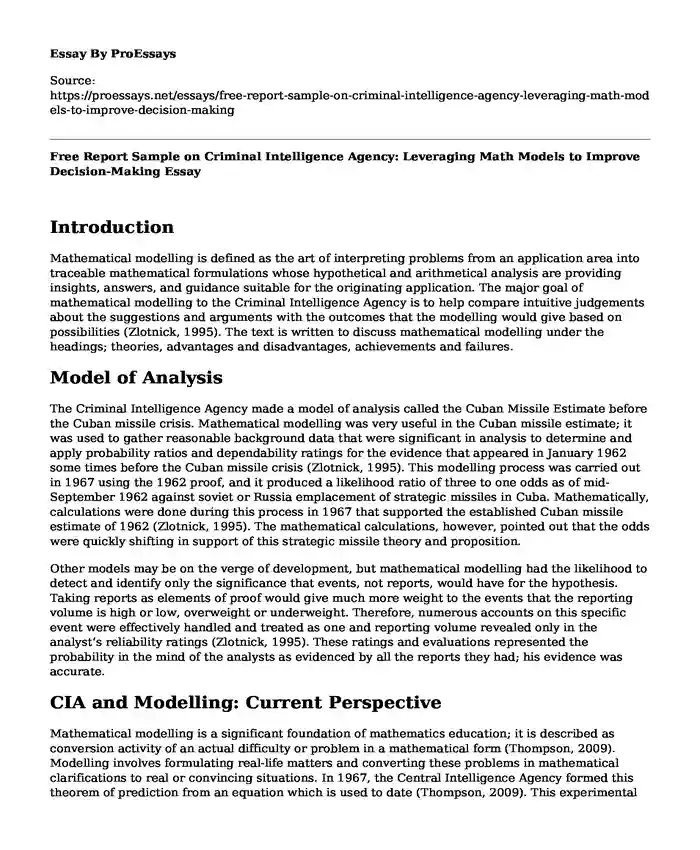Introduction
Mathematical modelling is defined as the art of interpreting problems from an application area into traceable mathematical formulations whose hypothetical and arithmetical analysis are providing insights, answers, and guidance suitable for the originating application. The major goal of mathematical modelling to the Criminal Intelligence Agency is to help compare intuitive judgements about the suggestions and arguments with the outcomes that the modelling would give based on possibilities (Zlotnick, 1995). The text is written to discuss mathematical modelling under the headings; theories, advantages and disadvantages, achievements and failures.
Model of Analysis
The Criminal Intelligence Agency made a model of analysis called the Cuban Missile Estimate before the Cuban missile crisis. Mathematical modelling was very useful in the Cuban missile estimate; it was used to gather reasonable background data that were significant in analysis to determine and apply probability ratios and dependability ratings for the evidence that appeared in January 1962 some times before the Cuban missile crisis (Zlotnick, 1995). This modelling process was carried out in 1967 using the 1962 proof, and it produced a likelihood ratio of three to one odds as of mid-September 1962 against soviet or Russia emplacement of strategic missiles in Cuba. Mathematically, calculations were done during this process in 1967 that supported the established Cuban missile estimate of 1962 (Zlotnick, 1995). The mathematical calculations, however, pointed out that the odds were quickly shifting in support of this strategic missile theory and proposition.
Other models may be on the verge of development, but mathematical modelling had the likelihood to detect and identify only the significance that events, not reports, would have for the hypothesis. Taking reports as elements of proof would give much more weight to the events that the reporting volume is high or low, overweight or underweight. Therefore, numerous accounts on this specific event were effectively handled and treated as one and reporting volume revealed only in the analyst’s reliability ratings (Zlotnick, 1995). These ratings and evaluations represented the probability in the mind of the analysts as evidenced by all the reports they had; his evidence was accurate.
CIA and Modelling: Current Perspective
Mathematical modelling is a significant foundation of mathematics education; it is described as conversion activity of an actual difficulty or problem in a mathematical form (Thompson, 2009). Modelling involves formulating real-life matters and converting these problems in mathematical clarifications to real or convincing situations. In 1967, the Central Intelligence Agency formed this theorem of prediction from an equation which is used to date (Thompson, 2009). This experimental application of probability mathematics is used by the Central Intelligence Agency today to foretell intelligent estimations illuminating possibilities and disciplinary potentials. Currently, the CIA has been using mathematical modelling and success has been experienced in most circumstances which are proof that theories supporting this modelling are true.
Conclusion
There are chances for error, especially when the expectations and predictions do not come to happen. These errors give the security teams no chance to fully trust mathematical modelling when handling security matters. Therefore other options and approaches are put in place to be used in case this modelling fails to work. Security events need critical thinking in decision making, requiring human analysis (Thompson, 2009). Human beings in whichever sector work solely to safeguard and expand other people’s freedom. Human security requires both protecting citizens from dangerous and persuasive threats and teaching individuals how to take charge of their own lives and security.
References
Thompson, C. (2009). Can Game Theory Predict When Iran Will Get the Bomb? New York Times
http://www.nytimes.com/2009/08/16/magazine/16Bruce-t.html?_r=0
Zlotnick, J. (1995). A Theorem for Prediction. Studies in Intelligence
https://www.cia.gov/library/center-for-the-study-of-intelligence/kent-csi/vol11no4/html/v11i4a01p_0001.htm
Cite this page
Free Report Sample on Criminal Intelligence Agency: Leveraging Math Models to Improve Decision-Making. (2023, Oct 12). Retrieved from https://proessays.net/essays/free-report-sample-on-criminal-intelligence-agency-leveraging-math-models-to-improve-decision-making
If you are the original author of this essay and no longer wish to have it published on the ProEssays website, please click below to request its removal:
- Threats of Closing the Southern Border - Essay Sample
- My Leadership Strengths and Areas for Growth: A Reflective Essay
- Roles of RNs & Nurse Leaders in Changing Healthcare: Evidence-Based Practice, Issues & Trends - Essay Sample
- Essay Sample on Mark Zuckerberg: A Humble and Visionary Leader
- Race, Social Vices, & US Crime: A Philosophical Analysis Essay
- Essay Example on Differentiation: A Vital Strategy for Market Leadership
- Essay Example on Tech Industry Diversity: Employer Perceptions, Stereotypes & Unfavourable Climate







